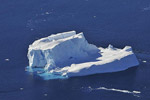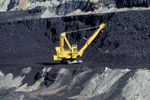Climate change is happening and humans are causing it, primarily from the increase in atmospheric carbon dioxide caused by burning fossil fuels. This much we know. The “secret” comes from changes happening in the fast-warming Arctic: we may be surprisingly close to an Earth that supports far fewer humans than it does today.
Permafrost and methane hydrates
In the Arctic, two things may become crucial: permafrost and methane hydrates. Permafrost—ground frozen for thousands of years—is a huge store of carbon, originating from long-dead plants and animals. As permafrost thaws, this carbon is released into the atmosphere as carbon dioxide or methane, both greenhouse gases that cause climate change. According to a NASA research report, “Is a Sleeping Climate Giant Stirring in the Arctic?” there is four to five times the amount of carbon in the permafrost than the sum total of all carbon humanity has emitted into the atmosphere since 1850.
 Methane hydrate. Photo by: Wusel007/Creative Commons 3.0. |
Methane doesn’t last as long as carbon dioxide in the atmosphere. But on a 20-year time scale, it’s 105 times as potent in causing global warming. In the Arctic Ocean, there is an immense amount of methane stored in ice, in a form called methane hydrates. According to a March 2010 report in Science, these methane hydrates are equivalent to 3-30 times the total amount of carbon dioxide humanity has emitted since the Industrial Revolution.
Permafrost and methane hydrates are pivotal because the Arctic (and Antarctic) is warming faster than anywhere else on the planet. By later this decade, according to many scientists, the Arctic could be completely free of ice in the summer. Already, permafrost has begun to thaw, and huge pools of methane are bubbling up from the Arctic Ocean.
Impacts
If a significant portion of permafrost and/or methane hydrates melts in a short period of time (think decades), the result may be catastrophic for humanity. Impacts we are already seeing from climate change would be magnified, including more intense major storms, reduced crop yields, more pests, higher sea levels, and more flooding, droughts and forest fires. These could be joined by a wholesale disruption of the jet streams, a complete change of weather patterns, and very rapid warming, which many, if not most, life forms could not survive. While humans might be able to handle the temperature rise, our food sources would not have enough evolutionary time to adapt.
Why isn’t this widely known?

Landscape with permafrost underneath. The permafrost creates landscape formations known as palsas. Photo by: Dentren/Creative Commons 3.0. |
Scientists rely on careful experimentation, verified by peer review, and supported by further experimentation; this generally slow process eventually results in unassailable knowledge. However, given the earth’s complexity, it is not yet understood how quickly these Arctic changes will happen, if there are other changes in the Arctic that might absorb some of the added carbon dioxide and methane, and exactly how the Earth will respond. These uncertainties, combined with the conservative scientific process, may be why the potential devastation from the Arctic has not been widely publicized.
An insurance policy?
While the likelihood of this nightmare scenario is unknown, there are coded warning signs coming from respectable scientists. One example is a July 2013 study in the journal Nature that indicated a 50-gigaton “burp” of methane from thawing Arctic permafrost beneath the East Siberian Sea is “highly possible at anytime.” This would be equivalent to roughly three times the total carbon dioxide emitted by humanity since the Industrial Revolution.
People spend significant sums of money every year on insurance to protect their families and children from unknown events. If the melting of Arctic permafrost and methane hydrates occurs, we put our children’s world at risk. It’s time to take out an insurance policy on our Earth habitat, in the form of immediate actions to reduce greenhouse gases. We know this needs to happen. The more we wait, the more risk we put on the shoulders of our children.
Actions
The world needs U.S. leadership now, and we’re not providing it. According to the Global Carbon Budget published by the Global Carbon Project in November, 2013, we have one of the highest per capita emission rates in the world, more than twice the amount of carbon dioxide per person than China, India, or the European Union.
Here are some actions you can take now:
- 1. Sign the petition at Wake Up to Climate Change to get Congress moving.
- 2. Demand from your congressional representatives a gradually increasing tax on carbon emissions. This is the single most effective thing we can do. Take a look at the Citizens’ Climate Lobby for a well-defined approach.
- 3. Talk about this issue with friends, family and others.
- 4. Reduce your own carbon footprint as much as possible.
It’s time to take immediate action. For our children, and grandchildren, the stakes could not be higher.
Citations:
- National Snow & Ice Data Center, Q&A with Kevin Schaefer, https://nsidc.org/cryosphere/frozenground/methane.html
- Tomgram: Dahr Jamail, The Climate Change Scorecard http://www.tomdispatch.com/blog/175785/
- Climate Reality Leadership Corps presentation, http://climaterealityproject.org/
Larry is a former high tech executive now traveling the world for a year on an environmentally focused trip with his wife and two children. They are sharing their learnings on their blog (http://krafttrip.blogspot.com/) and with The Wilderness Classroom, an environmental education non-profit. He can be reached at lkraft@hotmail.com or on twitter at @LarryKraft1.
Related articles
Tipping point already reached? West Antarctica in slow-motion, unstoppable melt

(05/14/2014) Two hundred years from now, the planet could look very different. This week two landmark studies revealed that West Antarctica’s ice sheet is in a state of seemingly inevitable collapse linked to climate change. The slow-motion collapse would by itself eventually lead to a rise in global levels of 3.6-4.5 meters (12-15 feet).
Featured video: John Oliver skewers media ‘balance’ on climate science in viral video
(05/13/2014) Sometimes you need comedians to tell the truth. On his new show, Last Week Tonight, comedian John Oliver took on the poor state of media reporting on climate science.
Underwater horrors: shells of marine life melting off the coast of the U.S.

(05/08/2014) It could be the plot of a horror movie: humans wake up one day to discover that chemical changes in the atmosphere are dissolving away parts of their bodies. But for small marine life known as sea butterflies, or pteropods, this is what’s happening off the West Cost of the U.S. Increased carbon in the ocean is melting away shells of sea butterflies.
Stanford kicks coal out of its $18 billion endowment

(05/07/2014) The fossil fuel divestment campaign won a major victory today as Stanford University announced it would drop coal companies from its massive $18.7 billion endowment, the fourth largest of any American university. The action follows a petition by student group Fossil Free Stanford and five months of research by Stanford’s Advisory Panel on Investment Responsibility and Licensing.
Cosmos’s Neil deGrasse Tyson on climate change: ‘What’s our excuse?’

(05/06/2014) America’s favorite astrophysicist, Neil deGrasse Tyson, tackled climate change on the most recent episode of the hit show, Cosmos: A Spacetime Odyssey. The episode, the ninth in the series, looked back on the climatic and physical upheavals undergone by Earth, before highlighting the mild interglacial climate that allowed the human species to kickstart the neolithic revolution and the first civilizations.
31 activists arrested attempting to stop Arctic oil from docking in Europe
(05/01/2014) Dutch police arrested 31 Greenpeace activists today, who were attempting to block the Russian oil tanker, Mikhail Ulyanov, from delivering the first shipment of offshore Arctic oil to the European market.













